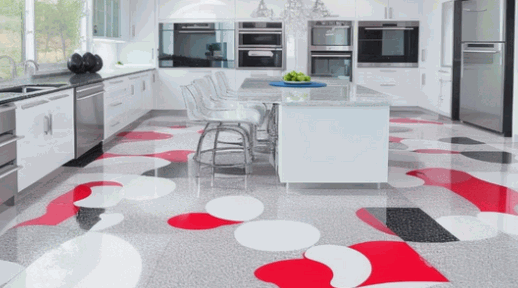When selecting the perfect flooring for your kitchen, there are many options. Epoxy flooring is a modern, durable option that has become popular lately. It’s made of two components: epoxy resin and hardener, which chemically bond to form a strong, durable surface.
Epoxy flooring is ideal for the kitchen because it can handle heavy traffic, spills, stains, and impact. Plus, cleaning up messes is easy because liquids and dirt can’t penetrate the seamless surface.
In addition to its durability, epoxy flooring also comes in many colors and finishes. From modern to rustic, there are endless possibilities.
Here are some tips for the best epoxy kitchen flooring experience:
- Hire a pro: Make sure to hire a professional contractor to install the epoxy flooring correctly.
- Prepare the surface: Before applying the epoxy, remove any existing coatings or impurities.
- Slip-resistant additives: Consider adding non-slip additives to the epoxy for extra safety in case of spills.
Overview Of Epoxy Flooring
Epoxy flooring is now popular in kitchens. It looks shiny and seamless, plus it’s easy to clean and can resist stains, chemicals, and moisture. It’s also tough against heavy foot traffic and kitchen appliances. Plus, you can customize it for any style. It also resists staining and corrosive cleaning agents.
To make the most of it, here are some tips:
- Prepare the surface before applying epoxy. Clean and etch it for a strong bond.
- Get an experienced professional for installation. This will avoid bubbling or peeling.
- Maintain it regularly. Clean with mild soap and avoid abrasive cleaners or tools. This will keep it looking new.
Learn more: Is Resin Flooring Suitable For Bathrooms
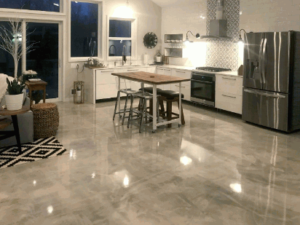
Advantages Of Epoxy Flooring In The Kitchen
Epoxy Flooring: Enhancing the Kitchen Experience
The benefits of having epoxy flooring in the kitchen are numerous and impactful. Firstly, it provides exceptional durability, ensuring longevity even in the face of heavy foot traffic and potential spills. Secondly, epoxy flooring is highly resistant to stains, making it easy to clean and maintain a sparkling kitchen environment. Additionally, its seamless and smooth surface prohibits the growth of bacteria and mold, promoting a hygienic space for food preparation.
Apart from these advantages, there are unique details worth mentioning. Epoxy flooring offers an array of design options, allowing homeowners to customize their kitchen floors according to their personal tastes. Furthermore, its seamless finish not only enhances the aesthetics but also eliminates the need for grout lines, which can accumulate dirt and debris over time.
Durability And Resistance To Stains
Epoxy flooring in the kitchen is incredibly durable and resistant to stains. It can withstand heavy foot traffic and objects without getting damaged. Plus, it’s highly resistant to spills! A comparison table on the advantages of epoxy flooring in the kitchen can be seen:
| Advantages of Epoxy Flooring in the Kitchen | ||||
|---|---|---|---|---|
|
Moreover, epoxy flooring is scratch, abrasion, and impact-resistant. It retains its appearance despite years of use. Plus, its seamless and glossy surface prevents dirt, dust, and bacteria buildup.
Easy To Clean And Maintain
Epoxy flooring offers numerous advantages. Firstly, it’s incredibly easy to clean – dirt, spills, and stains can’t penetrate the surface. So, wiping away mess with a mop or cloth is simple.
Plus, epoxy is highly resistant to chemicals and abrasions. It’s ideal for kitchens, where spills of oils, acids, and other substances can occur. Even tough stains can be removed without damage or discoloration.
Another benefit is the durability of epoxy flooring – minimal maintenance is required. No need for polishing or sealing, saving time and money.
And, epoxy provides hygiene benefits – bacteria and mold can’t hide in its seamless design, promoting a cleaner environment.
If you want a practical flooring solution with easy cleaning and low maintenance, choose epoxy! Enhance the cleanliness and longevity of your kitchen today!
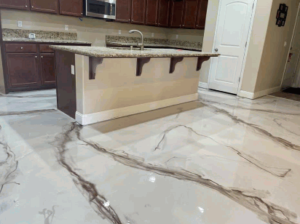
Enhanced Safety And Hygiene
Epoxy flooring in the kitchen brings many advantages for safety and hygiene. Let’s explore them!
Benefits of Epoxy Flooring:
- Slip-resistant Surface – Traction helps prevent accidents, lessening the chance of slips and falls.
- Chemical Resistance – Oils, acids, and other kitchen substances won’t cause stains, making it easy to clean.
- Seamless Design – No cracks or grout lines where dirt, bacteria, or pathogens can build up.
- Anti-microbial Properties – Inhibits the growth of bacteria on the surface, giving a healthier kitchen environment.
- High Durability – Can handle heavy foot traffic and impacts from utensils or equipment, and will last.
Plus, epoxy can be customized with colors or patterns to make the kitchen look good, without compromising safety or hygiene. It also withstands extreme temperatures and moisture-related damage. This makes it ideal for kitchens that have varying humidity levels and spills.
Don’t miss out! Upgrade your kitchen with epoxy and say goodbye to worries. Enjoy improved safety and easier maintenance routines. Get a cleaner, safer cooking space that looks good and contributes to your well-being.
Disadvantages Of Epoxy Flooring In The Kitchen
Epoxy Flooring in the Kitchen: Limitations and Concerns
Epoxy flooring offers several advantages for kitchen spaces, but it is not without its limitations. Here are some factors to consider before opting for epoxy flooring in your kitchen:
- Susceptible to heat and impact damage: While epoxy flooring is generally durable, it can be prone to damage from heavy objects or direct heat exposure. Dropping utensils or pots on the floor or placing hot cookware directly on the surface could cause cracks or discoloration.
- Difficult to repair: Unlike other types of flooring, repairing epoxy flooring can be challenging. If damage occurs, it may require the entire floor to be replaced rather than just simple patching.
- Slippery when wet: Epoxy flooring can become slippery when wet, especially if spills are not promptly cleaned. This poses a safety hazard, particularly in a kitchen environment where liquids are often present.
- Requires professional installation: Installing epoxy flooring requires specialized skills and knowledge. It is not a simple DIY project and should be handled by a professional to ensure proper application and long-lasting results.
- Limited design options: Epoxy flooring comes in a range of colors and finishes, but it doesn’t offer the same variety as other flooring options such as tiles or hardwood. If you have specific design preferences for your kitchen, epoxy flooring may not provide the desired aesthetic.
- Chemical sensitivity: Some people may be sensitive to the chemicals used in epoxy flooring. This can cause respiratory issues or skin irritation, making it important to consider the potential health effects before choosing this type of flooring.
Despite these limitations, epoxy flooring can still be a viable option for many kitchens. However, it’s crucial to weigh the advantages against the disadvantages and determine if it aligns with your specific needs and preferences.
If you decide to proceed with epoxy flooring, ensure that you hire a reputable professional to handle the installation. They can help address any concerns and ensure the floor is properly maintained to minimize potential issues.
Don’t miss out on exploring other flooring options for your kitchen. Consider all the factors, consult with experts, and make an informed decision that suits both your practical requirements and aesthetic preferences.
Installing epoxy flooring in your kitchen may cost a pretty penny, but at least you’ll have a shiny surface to reflect on when your bank account is empty.
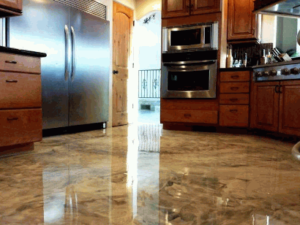
Initial Installation Cost
The cost of epoxy flooring in the kitchen differs, based on factors like size, installation complexity, and material quality. Check out a table showing installation costs per square foot below:
| Install Cost/Square Foot | Small Kitchen (100 sq ft) | Medium Kitchen (200 sq ft) | Large Kitchen (300 sq ft) |
|---|---|---|---|
| $4 – $8 | $400 – $800 | $800 – $1,600 | $1,200 – $2,400 |
Bear in mind these are just estimates. Other costs like preparation or customizations can increase the final cost.
It’s worth thinking about the long-term advantages of epoxy flooring too. It’s durable, resistant to stains, moisture, and chemicals, and requires minimal upkeep.
Pro Tip: Talk with pros who specialize in epoxy flooring. They can provide exact cost quotes according to your kitchen needs.
Susceptibility To Scratches And Chips
Epoxy flooring in the kitchen may have some advantages such as durability and a seamless surface, but it can be prone to scratches and chips. Sharp or heavy objects, force applied to dropped items, and wear and tear can all cause damage to the surface. Temperature, cleaning agents, and abrasives can also lead to surface damage. If the epoxy coating is not applied correctly or maintained properly, scratches and chips are even more likely.
Homeowners should consider their lifestyle before opting for this type of flooring. The International Journal of Industrial Ergonomics found that epoxy flooring offers benefits such as ease of maintenance and improved safety, but it comes with the disadvantage of being vulnerable to scratches and chips. Regular maintenance may be required to keep it looking nice.
Limited Design Options
Epoxy flooring in the kitchen may have a few design options. Let’s find out why.
Many homeowners dream of a beautiful kitchen. However, epoxy flooring can be limited. Here’s why:
| Column 1 | Column 2 |
|---|---|
|
|
These limitations can make it hard to get the perfect epoxy flooring for your desired kitchen. Compared to other flooring like tiles or wood, epoxy can be dull and lack variety.
Additional issues worth mentioning are:
- Custom designs require professional installation and cost more.
- Unlike other flooring materials, epoxy cannot be replaced or changed once installed.
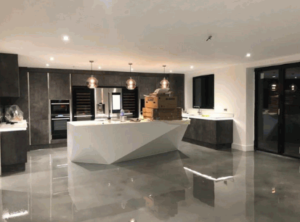
Conclusion
Epoxy flooring is great for kitchens. It’s durable and resists stains, heat, and moisture. Plus, it’s easy to clean! It’s also able to withstand heavy foot traffic and impacts. In a kitchen, where spills and dropped utensils are common, this is a huge benefit. Plus, epoxy is resistant to chemicals, keeping the kitchen environment safe.
Epoxy has no grout lines or seams so dirt and bacteria won’t collect. This makes it hygienic, even in commercial settings where food safety is essential. Seams also stop water and liquids from seeping into the subfloor, reducing the risk of mold.
Epoxy is also customizable. It comes in many colors and finishes. You can design a kitchen floor that fits your style or branding. Go for solid colors, metallic flakes, or decorative patterns. The possibilities are endless!
Pro Tip: To keep your epoxy flooring looking good in the kitchen, sweep away dirt and debris. Clean up spills quickly. This will stop any potential damage or staining.

